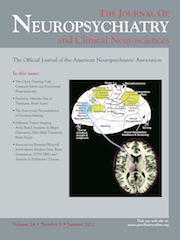Paliperidone as an Alternative for Risperidone in a Case of Schizophrenia With Retrograde Ejaculation
To the Editor: Risperidone is an atypical antipsychotic agent. Compared with other antipsychotics, risperidone is a potent α1 adrenoreceptor antagonist, with a high affinity (Ki of 0.69).1 There are specific adverse effects of this property. Significant among them is retrograde ejaculation.2–5 The impact of risperidone, a strong α1-receptor antagonist, on the adrenergic system might induce retrograde ejaculation by altering sympathetic tonus, allowing semen to go retrograde into the bladder during ejaculation. The management of antipsychotic drug-induced sexual dysfunction is primarily directed toward avoiding the mechanism of the adverse effect, whether it is prominent dopamine blockade, elevated prolactin levels, or α-adrenergic blockade.4 Here, a case of risperidone-induced retrograde ejaculation that was successfully managed with paliperidone (9-OH risperidone) is presented.
“Mr. A,” a 29-year-old man, was brought to the psychiatry outpatient department with a history of abnormal behavior for the past 8 months. Initially, his mother noted that he was becoming irritable and aggressive without any reason. He was expressing persecutory and referential ideas about his sister. Gradually, it was noted that his interactions with others had decreased. His occupational functioning deteriorated in the form of poor quality of work and absenteeism. During the next 2 months, he was locking himself inside his room for long hours. He had bizarre delusions and derogatory/commanding-type auditory hallucinations. A diagnosis of paranoid schizophrenia was made. His physical examination was normal. He was started on risperidone 2 mg and titrated up to 3 mg bid. In the next month, he showed significant improvement. After 6 weeks, he reported after defaulting on drugs for about a week. He had stopped medication because he was having orgasms without ejaculation on masturbation. He was highly distressed about this symptom. His serum prolactin level was 330 mI/L, within normal limits. Analysis of his post-orgasmic urine showed a significant number of motile sperms. He was diagnosed with risperidone-induced retrograde ejaculation. He was not willing to take the same medication, even at a lower dose. He also had started hearing the commanding voices on and off again. It was clinically a difficult decision to withhold risperidone, since it had helped him very well. The psychotic symptoms might resurface until another drug takes over its action. So it was decided in this case to prescribe an alternative antipsychotic that has a (nearly) similar pharmacokinetic and pharmacodynamic profile.1,6 He was started on paliperidone 3 mg, increased to 9 mg. He was followed up for the next 6 months. His psychotic symptoms were under control. Most importantly, he was able to have a normal orgasm and ejaculation during this period. He was very comfortable in continuing the medication.
Discussion
In this case, the retrograde ejaculation was most probably due to α1 adrenoreceptor blockade, since the prolactin level was within normal limits. It remitted on replacing risperidone with paliperidone. Risperidone is a potent blocker of α1 adrenergic receptors, >3 times that of paliperidone. This profile of paliperidone significantly matched this patient’s need.1 For ethical and clinical reasons, there was no washout period for risperidone allowed; but the patient was under follow-up for an adequate period, so that it was very clear that the desired effects were from paliperidone and not residual risperidone; and, for the same reason, re-challenging with risperidone not tried. The argument that paliperidone is relatively safer in its α1 adrenergic blockade is reinforced by a case of paliperidone toxicity (up to 756 mg), where almost no signs of such adverse effects were noted.7 Another reported case of paliperidone overdose (81 mg) also had α2 adrenergic receptor blockade (tachycardia and hypertension), rather than α1 receptor.8 These two case reports are indirect clinical evidence that, for psychotic patients who are prone to α1 adrenergic receptor-related side effects, paliperidone might be a better option.
Medication adherence with antipsychotics is adversely affected by the burden of untoward adverse effects. In particular, sexual side effects may interfere with compliance, but they are often underreported by patients. So this case gives us a suggestion that paliperidone can be considered as an alternative when antipsychotic-induced retrograde ejaculation interferes with treatment.
1 : The pharmacokinetics of paliperidone versus risperidone. Psychosomatics 2010; 51:80–88Crossref, Medline, Google Scholar
2 : Effects of psychotropic drugs on human erection and ejaculation. Arch Gen Psychiatry 1989; 46:275–284Crossref, Medline, Google Scholar
3 : Risperidone-induced retrograde ejaculation. Am J Psychiatry 2001; 158:650Crossref, Medline, Google Scholar
4 : Sexual dysfunction and psychotropic medications. CNS Spectr 2006; 11(Suppl 9):24–30Crossref, Medline, Google Scholar
5 : Risperidone-associated ejaculatory and urinary dysfunction in male adolescents. J Child Adolesc Psychopharmacol 2003; 13:107–109Crossref, Medline, Google Scholar
6 : Do novel antipsychotics have similar pharmacological characteristics? a review of the evidence. Neuropsychopharmacology 1998; 18:63–101Crossref, Medline, Google Scholar
7 : [Non-fatal paliperidone overdose: a case report]. Turk Psikiyatri Derg 2010; 21:331–334Medline, Google Scholar
8 : Paliperidone overdose in a patient with schizophrenia. Prog Neuropsychopharmacol Biol Psychiatry 2010; 34:418Crossref, Medline, Google Scholar



